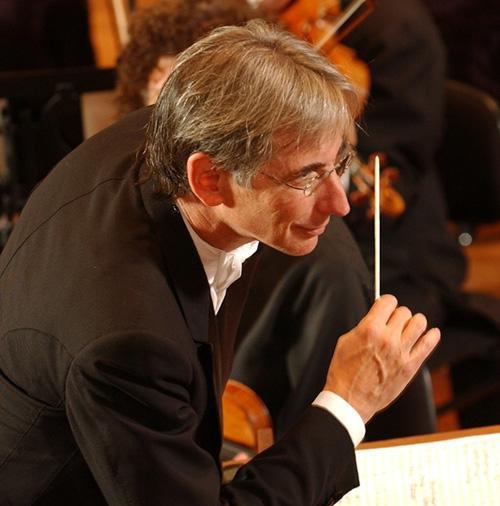Michael Tilson Thomas’s association with the London Symphony Orchestra runs deep - he was its principal conductor for eight years, and for his latest return to his old band last night the American programmed works that, while they had a Viennese theme, also seemed vividly designed to show off the jewels of this great orchestra, its wonderful wind players. How the clarinettists, oboists, flautists, horn-players and trumpeters must have delighted to see what they were to play: Schubert’s Donizetti-like Rosamunde, with its haunting woodwind songs, Mahler’s richly picturesque song cycle Des Knaben Wunderhorn, resounding with trumpets and oboes, and Berg’s epic Three Pieces for Orchestra, a showpiece fielding double rations of winds, brass, percussion - and a gigantic hammer.
Schubert, Mahler and Berg are united by Viennese identity as composers, and that thick, strong bloodline of cantabile melody leapfrogs painlessly across a century - Schubert and Mahler both evidently inspired by folk song and romanticism, Berg being Mahler’s offspring in all but his tonality. If you’re used to Schubert’s piercing conciseness in his Lieder, his incidental Rosamunde music (cursed by being written to accompany a dreadful play that closed on its second night) feels over-expansive, filling half an hour without doing much more than pleasing the ear at length.
The middle movement is rightly famous, with its wistful major key melody returning and returning on violins, interspersed with the bird-like calls of woodwind. The third attempts a more peremptory, symphonic effect, but it lacks the substance for a symphony’s final movement. Still the imagination has something to play with, the thought of such very long musical entr’actes between spoken scenes, and another two ballets and four vocal scenes, surrounding verbal dross.
The verbal standard of Mahler’s Des Knaben Wunderhorn is rustic but good, a group of 13 folklore poems entitled “The youth’s magic horn” which he set variously to piano and orchestra, and which can be shuffled about and cut to make a variety of experiences, according to the singer. The landmark recording by Dietrich Fischer-Dieskau and Elisabeth Schwarzkopf has 12 songs; their pupil Matthias Goerne made a quite different impression with his own cut of six songs here.
Goerne’s velvety baritone voice needs no further praise from me, nor his overwhelming imaginative intelligence
Goerne’s velvety baritone voice needs no further praise from me, nor his overwhelming imaginative intelligence in this repertory. Typically, he offered a highly personalised reading, tying his choice of songs into its own tight and introverted narrative that you would readily recognise as Goernian, even Schubertian.
Here was a young soldier drummer in military jail (he began with “Lied des Verfolgten im Turm”) experiencing his last day, dreaming of visiting his love as she slept (“Wo die schönen Trompeten blasen”), ruminating on man’s indomitable refusal to change despite all that God can say (St Anthony of Padua’s sermon to the fishes and “Urlicht”), recalling the battle (“Revelge”) in which his comrades were cut down and he lost his mind and deserted, and then facing the gallows in “Der Tamboursg’sell” (The Drummer-boy).
Tilson Thomas raised every colour of description and emotion in accord with this implied story, not afraid to challenge Goerne’s soft-grained voice with some brisk morning trumpets in the second song, and building a heartless, almost gaudy climax of woodwind cries for the battle in the mighty “Revelge” (Reveille). “Tamboursg’sell” is in a key too low for Goerne comfortably, but Tilson Thomas brushed the orchestra past him by the end in an exact illustration of events overtaking a boy soldier who dies anonymously. All in all, a stirring performance, particularly acute on Remembrance Sunday.
After the interval, Mahler’s Blumine - an intensely sweet waltzing movement he dropped from the First Symphony, but which like Schubert’s Rosamunde was probably a bit of incidental music (they don’t make theatre scores the way they used to) - dazzlingly deployed the LSO’s honeyed string sound and featured a stellar array of solos, from the trumpet to a snatch of cello. It was a luxury bonne bouche before the explosive orchestral richness of the Berg, for which the orchestra almost doubled in size from its opening Schubert numbers.
Despite the throwaway name, the Three Pieces for Orchestra, from 1915, are Mahlerian in scope, gorging on aural possibilities, beginning with the untuned rustle of drums and cymbals. “Praeludium” builds terraces of gruff brass, trombones and triumphant oboes in a steady crescendo; the much more insinuating, enchanting “Reigen” (meaning Round dance) swirls in a sort of tavern waltz, with soloists emerging briefly out of the haze like faces from a dream; the “Marsch” is a thrillingly massive outlay of militaristic orchestral sounds, coming to a jolting stop, and then rebuilding swiftly under trombones and gongs to an ear-pulverising fortissimo.
Tilson Thomas commanded all this like a captain confident with the smallest eddy and the vastest wave, delivering a concert of true musical excitement.
- The LSO and Tilson Thomas perform Schubert, Mahler and Berg tonight in Dublin's National Concert Hall. Book online here. Michael Tilson Thomas's website. The London Symphony Orchestra website
- Check out what's on at the Barbican Centre this season














Add comment